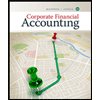
FINANCIAL ACCT.FUND.(LOOSELEAF)
7th Edition
ISBN: 9781260482867
Author: Wild
Publisher: MCG
expand_more
expand_more
format_list_bulleted
Concept explainers
Question
Chapter 5, Problem 10E
To determine
Introduction: LCM (lower of cost or market value) method of
:The Inventory valuation under LCM method.
Expert Solution & Answer
Want to see the full answer?
Check out a sample textbook solution
Students have asked these similar questions
What is raghus contribution margin rate?
After the first payment was made the note payable liability
What was the company's opereting cash flow? Given answer
Chapter 5 Solutions
FINANCIAL ACCT.FUND.(LOOSELEAF)
Ch. 5 - Use the following information from Marvel Company...Ch. 5 - Use the following information from marvel company...Ch. 5 - Use the following information from Marvel Company...Ch. 5 - Use the following information from Marvel company...Ch. 5 - Periodic: A company reports the following...Ch. 5 - Prob. 6MCQCh. 5 - Prob. 1DQCh. 5 - Prob. 2DQCh. 5 - Prob. 3DQCh. 5 - Prob. 4DQ
Ch. 5 - Prob. 5DQCh. 5 - Prob. 6DQCh. 5 - Prob. 7DQCh. 5 - Prob. 8DQCh. 5 - Prob. 9DQCh. 5 - Prob. 10DQCh. 5 - Prob. 11DQCh. 5 - Prob. 12DQCh. 5 - Prob. 1QSCh. 5 - Prob. 2QSCh. 5 - Prob. 3QSCh. 5 - Prob. 4QSCh. 5 - Prob. 5QSCh. 5 - Prob. 6QSCh. 5 - Prob. 7QSCh. 5 - Prob. 8QSCh. 5 - Prob. 9QSCh. 5 - Prob. 10QSCh. 5 - Prob. 11QSCh. 5 - Prob. 12QSCh. 5 - Prob. 13QSCh. 5 - Prob. 14QSCh. 5 - Prob. 15QSCh. 5 - Prob. 16QSCh. 5 - Prob. 17QSCh. 5 - Prob. 18QSCh. 5 - Prob. 19QSCh. 5 - Prob. 20QSCh. 5 - Prob. 21QSCh. 5 - Prob. 22QSCh. 5 - Prob. 23QSCh. 5 - Prob. 1ECh. 5 - Prob. 2ECh. 5 - Prob. 3ECh. 5 - Prob. 4ECh. 5 - Prob. 5ECh. 5 - Prob. 6ECh. 5 - Prob. 7ECh. 5 - Prob. 8ECh. 5 - Prob. 9ECh. 5 - Prob. 10ECh. 5 - Prob. 11ECh. 5 - Prob. 12ECh. 5 - Prob. 13ECh. 5 - Prob. 14ECh. 5 - Prob. 15ECh. 5 - Prob. 16ECh. 5 - Prob. 17ECh. 5 - Prob. 18ECh. 5 - Prob. 19ECh. 5 - Perpetual: Alternative cost flows P1 Warnerwoods...Ch. 5 - Periodic: Alternative cost flows P3 Refer to the...Ch. 5 - Perpetual: Alternative cost flows P1 Montoure...Ch. 5 - Prob. 4PSACh. 5 - Prob. 5PSACh. 5 - Analysis of inventory errors A2 Navajo Company’s...Ch. 5 - Prob. 7PSACh. 5 - Periodic: Income comparisons and cost flows A1P3...Ch. 5 - Prob. 9PSACh. 5 - Prob. 10PSACh. 5 - Prob. 1PSBCh. 5 - Prob. 2PSBCh. 5 - Prob. 3PSBCh. 5 - Prob. 4PSBCh. 5 - Lower of cost or market P2 A physical inventory of...Ch. 5 - Analysis of inventory errors A2 Hallam Company’s...Ch. 5 - Prob. 7PSBCh. 5 - Periodic: Income comparisons and cost flows A1P3...Ch. 5 - Prob. 9PSBCh. 5 - Prob. 10PSBCh. 5 - Prob. 5SPCh. 5 - Prob. 1AACh. 5 - Prob. 2AACh. 5 - Prob. 3AACh. 5 - Prob. 1BTNCh. 5 - Prob. 2BTNCh. 5 - Prob. 3BTNCh. 5 - Prob. 4BTNCh. 5 - Prob. 5BTNCh. 5 - Visit four retail stores with another classmate....
Knowledge Booster
Learn more about
Need a deep-dive on the concept behind this application? Look no further. Learn more about this topic, accounting and related others by exploring similar questions and additional content below.Similar questions
- Need solutionarrow_forwardThe weighted average contribution margin is?arrow_forwardUse the information provided by iLembe Enterprises to answer the following questions independently. The expanded contribution margin model must be used to answer questions 3.3 to 3.5. 3.1 Use the contribution margin ratio to calculate the break-even value. 3.2 Determine the selling price per unit (expressed to the nearest cent) that will enable iLembe Enterprises to break even. 3.3 Calculate the sales volume required to achieve an operating profit of R2 001 000. 3.4 Calculate the total Contribution Margin and Operating Profit/Loss if the sales price drops by 10%. 3.5 The management of iLembe Enterprises is considering an increase of R100 000 in the advertising expenditure with the expectation that the sales volume will increase by 1 000 units. Will the profitability improve? Motivate your answer with the relevant calculationsarrow_forward
arrow_back_ios
SEE MORE QUESTIONS
arrow_forward_ios
Recommended textbooks for you
 Financial & Managerial AccountingAccountingISBN:9781285866307Author:Carl Warren, James M. Reeve, Jonathan DuchacPublisher:Cengage Learning
Financial & Managerial AccountingAccountingISBN:9781285866307Author:Carl Warren, James M. Reeve, Jonathan DuchacPublisher:Cengage Learning Corporate Financial AccountingAccountingISBN:9781305653535Author:Carl Warren, James M. Reeve, Jonathan DuchacPublisher:Cengage Learning
Corporate Financial AccountingAccountingISBN:9781305653535Author:Carl Warren, James M. Reeve, Jonathan DuchacPublisher:Cengage Learning Corporate Financial AccountingAccountingISBN:9781337398169Author:Carl Warren, Jeff JonesPublisher:Cengage Learning
Corporate Financial AccountingAccountingISBN:9781337398169Author:Carl Warren, Jeff JonesPublisher:Cengage Learning Financial & Managerial AccountingAccountingISBN:9781337119207Author:Carl Warren, James M. Reeve, Jonathan DuchacPublisher:Cengage LearningPrinciples of Accounting Volume 1AccountingISBN:9781947172685Author:OpenStaxPublisher:OpenStax College
Financial & Managerial AccountingAccountingISBN:9781337119207Author:Carl Warren, James M. Reeve, Jonathan DuchacPublisher:Cengage LearningPrinciples of Accounting Volume 1AccountingISBN:9781947172685Author:OpenStaxPublisher:OpenStax College Intermediate Accounting: Reporting And AnalysisAccountingISBN:9781337788281Author:James M. Wahlen, Jefferson P. Jones, Donald PagachPublisher:Cengage Learning
Intermediate Accounting: Reporting And AnalysisAccountingISBN:9781337788281Author:James M. Wahlen, Jefferson P. Jones, Donald PagachPublisher:Cengage Learning

Financial & Managerial Accounting
Accounting
ISBN:9781285866307
Author:Carl Warren, James M. Reeve, Jonathan Duchac
Publisher:Cengage Learning

Corporate Financial Accounting
Accounting
ISBN:9781305653535
Author:Carl Warren, James M. Reeve, Jonathan Duchac
Publisher:Cengage Learning

Corporate Financial Accounting
Accounting
ISBN:9781337398169
Author:Carl Warren, Jeff Jones
Publisher:Cengage Learning

Financial & Managerial Accounting
Accounting
ISBN:9781337119207
Author:Carl Warren, James M. Reeve, Jonathan Duchac
Publisher:Cengage Learning

Principles of Accounting Volume 1
Accounting
ISBN:9781947172685
Author:OpenStax
Publisher:OpenStax College

Intermediate Accounting: Reporting And Analysis
Accounting
ISBN:9781337788281
Author:James M. Wahlen, Jefferson P. Jones, Donald Pagach
Publisher:Cengage Learning
Chapter 6 Merchandise Inventory; Author: Vicki Stewart;https://www.youtube.com/watch?v=DnrcQLD2yKU;License: Standard YouTube License, CC-BY
Accounting for Merchandising Operations Recording Purchases of Merchandise; Author: Socrat Ghadban;https://www.youtube.com/watch?v=iQp5UoYpG20;License: Standard Youtube License